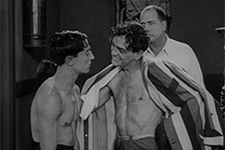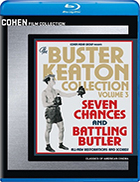Battling Butler
|  In Battling Butler, which was based on a Broadway musical hit that has since been largely forgotten, Buster Keaton plays another version of the innocuous, spoiled man-boy he first played in the short film The Saphead (1920) and all but perfected in his feature The Navigator (1924). Keaton’s signature stone-faced persona adds comedy and charm to characters of extreme wealth whose elaborate, pampered lifestyles would otherwise make them insufferable. Keaton makes his spoiled playboys seem amusingly naïve; having known no other life, they can’t conceive of how ridiculous their station and reliance on others for the simplest of tasks really is. Such is the case with Keaton’s character here, Alfred Butler, whose sedentary life of comfort and affluence is so absurd that his father forces him to “rough it” by going on a hunting and fishing trip that will hopefully make him “be a man.” Alfred obliges, but he brings along his personal valet (Snitz Edwards), who grills him steaks and makes him drinks and irons his extensive wardrobe of stylish garb while he sleeps in a tent large enough to house an entire bedroom suite. Rather than escaping to the great outdoors, Alfred the aimless aristocrat simply brings his life of cushy luxury with him. It is during this trip that Alfred meets a pretty mountain girl (Sally O’Neil), with whom he is immediately smitten and wants to marry. The problem is that her father (Walter James) and brother (Budd Fine) are tough, strapping men of the land who don’t have much affection for pampered rich boys. So, to prove his bona fides, Alfred pretends to be a professional lightweight boxer, which duly impresses them, but also creates a ruse that he must work hard to maintain. Much of the film’s comedy derives from Alfred’s desperate attempts to keep up the ruse that he is a professional fighter in training, when he is actually a diminutive milquetoast whose theft of a real fighter’s identity (Francis McDonald) is bound to catch up with him. And catch up it does, leading to the film’s lengthy training sequence in which he believes he is preparing to duke it out with a fighter dubbed “The Alabama Murderer,” although he ultimately ends up fighting the real Battling Butler in the locker room, an element that Keaton added to the original play. The fight sequence is a curious anomaly in Keaton’s career, which typically found him escaping violence through pluck and creativity and sheer luck, rather than aggression and violence. But here he finds his inner tough guy and beats the prize fighter through sheer force of will, which surprises Alfred as much as it does us (interestingly, Harold Lloyd would do something similar the next year in The Kid Brother, in which his otherwise timid glasses character fights viciously and victoriously when pushed too far). While the fight is what most people will remember, what makes Battling Butler unique is the genuine sense of romance between Alfred and the mountain girl. His falling in love with her and desire to marry her comes out of nowhere, but the screen chemistry between Keaton and Sally O’Neil is quite palpable, and there is a sweetness in her desire to be with him even as he is trying to escape her to maintain the duplicity. There is also great chemistry between Keaton and Snitz Edwards, who had previously appeared opposite him as a lawyer in Seven Chances, but here has a much larger and funnier role as Alfred’s unflappable, utterly reliable valet. One of the running gags in the film is that, every time Alfred is faced with a difficult situation, he simply turns to his valet and orders him to “Arrange it,” which he invariably does. The joke is rhythmically repeated throughout the film, but it also works on an ironic meta-level given the extensive involvement Keaton the artist had in his films as director and performer. Battling Butler was a major hit at the time—arguably Keaton’s biggest box office success of the 1920s—and while it is not as heralded as some of his other features, its success was what enabled him to make his follow-up feature, The General (1927), which many critics and historians consider his greatest film and one of the greatest of silent-era comedies.
Copyright © 2019 James Kendrick Thoughts? E-mail James Kendrick All images copyright © Cohen Film Collection | |||||||||||||||||||||||||||||
Overall Rating: 

 (3)
(3)


